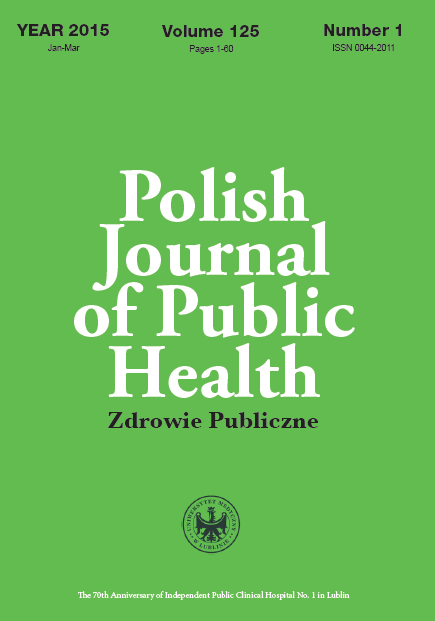The new era in the treatment of deep vein occlusion
DOI:
https://doi.org/10.1515/pjph-2015-0020Keywords:
post-thrombotic syndrome, DVT-deep venous thrombosis, venous stentingAbstract
A non-invasive, conservative treatment has been a standard in treating acute and chronic deep vein thrombosis. This treatment turned out to be ineffective, particularly in the hip area. Also, it was demonstrated that it does not influence the frequency of manifestations of post-thrombotic syndrome. Previous attempts to surgically reconstruct deep veins, unlike arteries reconstruction, yielded no positive results and also increased hemorrhagic and embolic complications. Currently, already
in the period of the acute thrombosis of deep veins, the methods of early re-canalization, both with the application of targeted thrombolisis, as well as of pharmacomechanical methods, are applied.
Thanks to a wide array of image examination methods applied in pre-operational and intra-operational diagnostics optimum, it is possible to plan a revascularising treatment in the sick individuals suffering from the already developed manifestations of the post-thrombotic syndrome.
The development of endovascular methods, made possible thanks both to the surgeons’ experience in the re-canalization field, as well as constant improvements of stents dedicated to the venous system, allowed for effective use of these techniques in curing the occlusion of deep veins. It was the case with the arterial system and works here as well. Applying the hybrid proceeding, combining opened techniques and endovascular ones, works very well in selected cases.
References
1. Wittens C. Best practice in venous procedures. Italy: Edizioni Minerva Medica; 2010.
2. Saarinen J, Kallio T, Lehto M, et al. The occurrence of the post-thrombotic changes after an acute deep vein thrombosis. A prospective twoyear follow-up study. J Cardiovasc Surg (Torino). 2000;41(3):441-6.
3. Neglen P, Raju S. Proximal lower extremity chronic venous outflow obstruction: recognition and treatment. Semin Vasc Surg. 2002;15:57-64.
4. Neglen P, Raju S. Intravascular ultrasound scan evaluation of the obstructed vein. J Vasc Surg. 2002;35:694-700.
5. Hsieh MC, Chang PY, Hsu WH, et al. Role of three-dimensional rotational venography in evaluation of the left iliac vein in patients with chronic lower limb edema. Int J Cardiovasc Imaging. 2011;27:923-9. [Web of Science]
6. Watson LI, Armon MP. Thrombolysis for acute deep vein thrombosis. Cochrane Database Syst Rev. 2004;4:CD002783. [Web of Science]
7. Ly B, Njaastad AM, Sandbaek G, et al. Catheter-directed thrombolysis of iliofemoral venous thrombosis. Tidsskr Nor Laegeforen. 2004;124:478-80.
8. Nazzal M, El-Fedaly M, Kazan V, et al. Incidence and clinical significance of iliac vein compression. Vascular. 2014 Nov 14. pii: 1708538114551194. [Epub ahead of print]
9. Wax JR, Pinette MG, Rausch D, Cartin A. May-Thurner syndrome complicating pregnancy: a report of four cases. J Reprod Med. 2014;59(5-6):333-6.
10. Chung JW, Yoon CJ, Jung SI, et al. Acute iliofemoral deep venous thrombosis: evaluation of underlying anatomic abnormalities by spiral venography. J Vasc Interv Radiol. 2004;15:249-56. [CrossRef]
11. Mathur M, Cohen M, Bashir R. May-Thurner syndrome. Circulation. 2014;129(7):824-5. [Web of Science]
12. Rao AS, Konig G, Leers SA, et al. Pharmacomechanical thrombectomy for iliofemoral deep vein thrombosis: an alternative in patients with contraindications to thrombolysis. J Vasc Surg. 2009;50:1092-8.
13. de Graaf R, Wittens CH. Endovascular treatment options for chronic venous obstructions. Phlebology. 2012;27(Suppl. 1):171-7.
14. Vogel DCA, Al-Jabouri M, Assi ZI. Common femoral endovenectomy with iliocaval endoluminal recanalization improves symptoms and quality of life in patients with postthrombotic iliofemoral obstruction. J Vasc Surg. 2012;55:129-35. [Web of Science]
Downloads
Published
Issue
Section
License
Copyright (c) 2015 Polish Journal of Public Health

This work is licensed under a Creative Commons Attribution-NonCommercial-NoDerivatives 3.0 Unported License.


